Unit 8 It must belong to Carla. Section-B 1a-2e课件(39张PPT 无音频)
文档属性
| 名称 | Unit 8 It must belong to Carla. Section-B 1a-2e课件(39张PPT 无音频) |  | |
| 格式 | zip | ||
| 文件大小 | 4.4MB | ||
| 资源类型 | 教案 | ||
| 版本资源 | 人教新目标(Go for it)版 | ||
| 科目 | 英语 | ||
| 更新时间 | 2019-05-20 19:45:20 | ||
图片预览

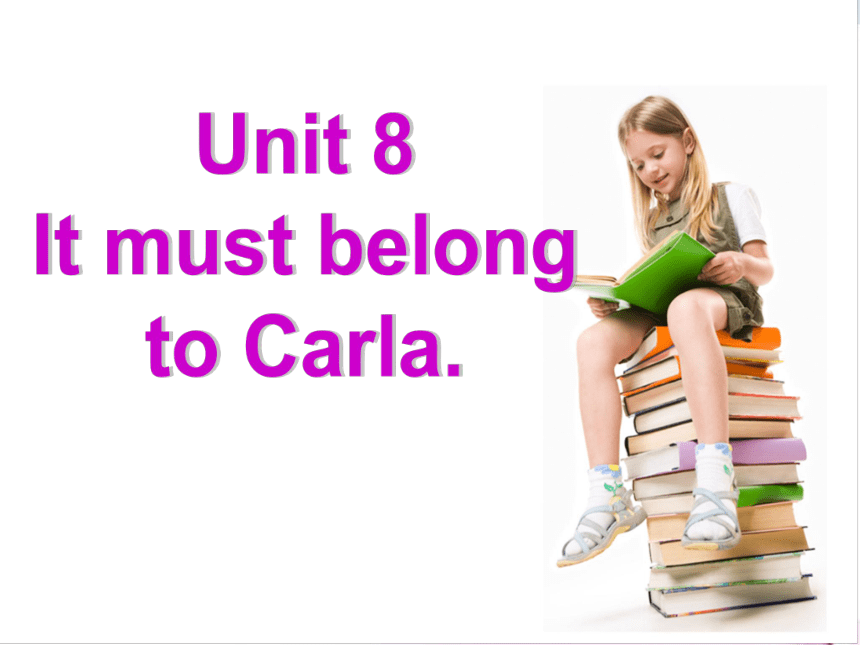
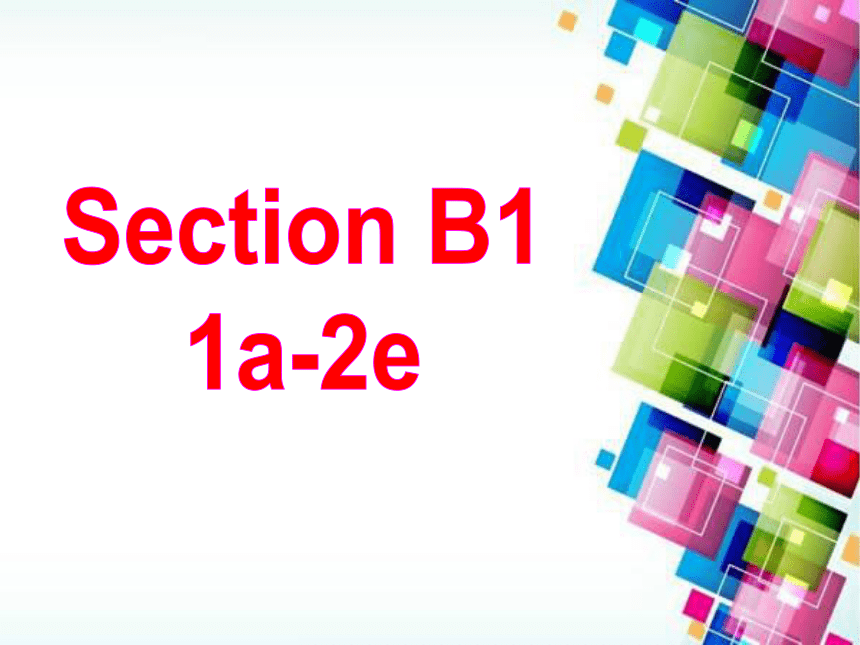
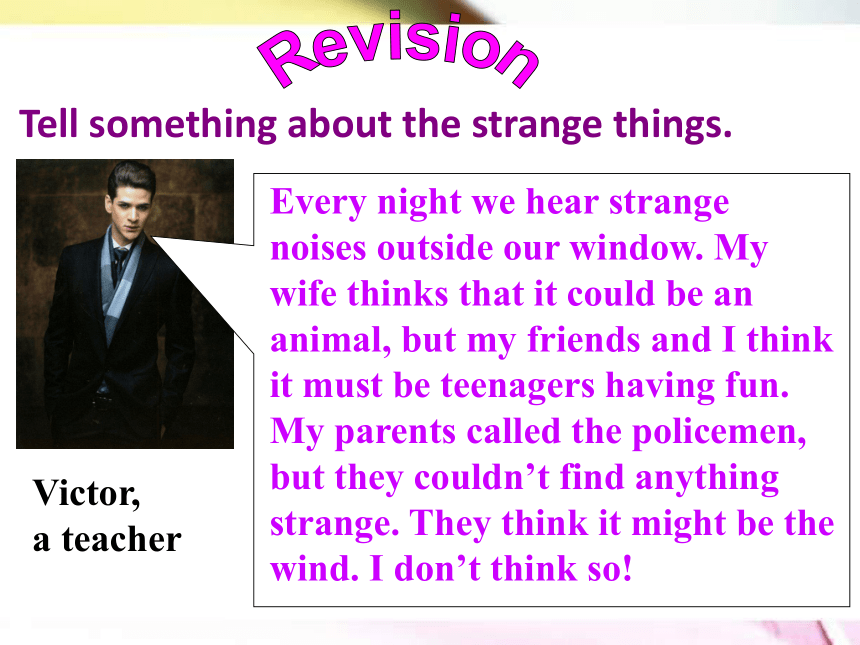

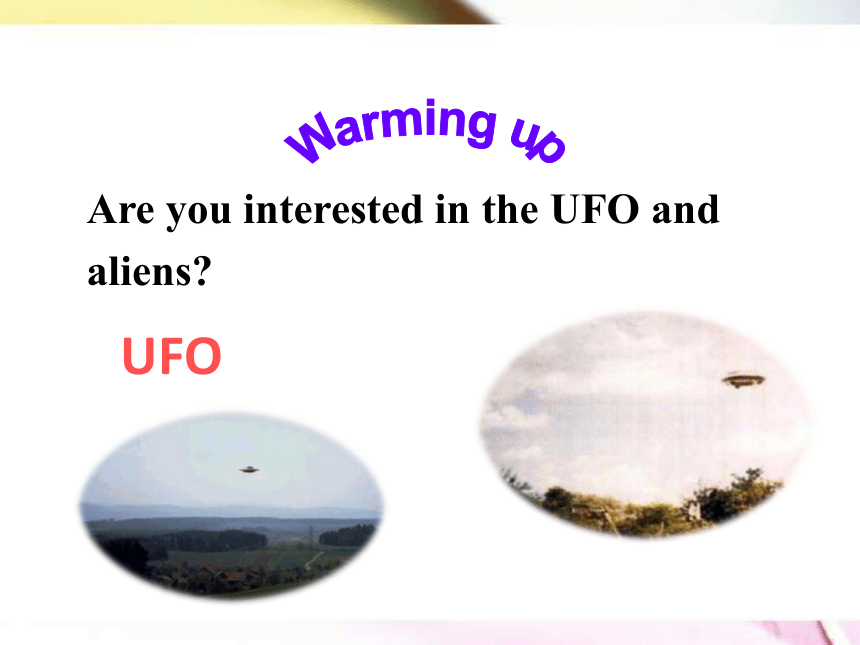
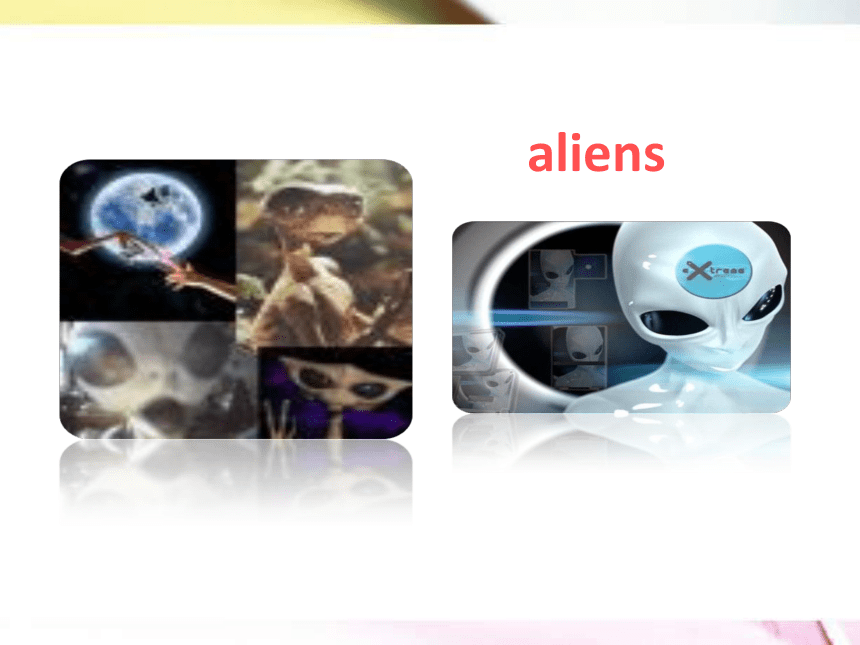
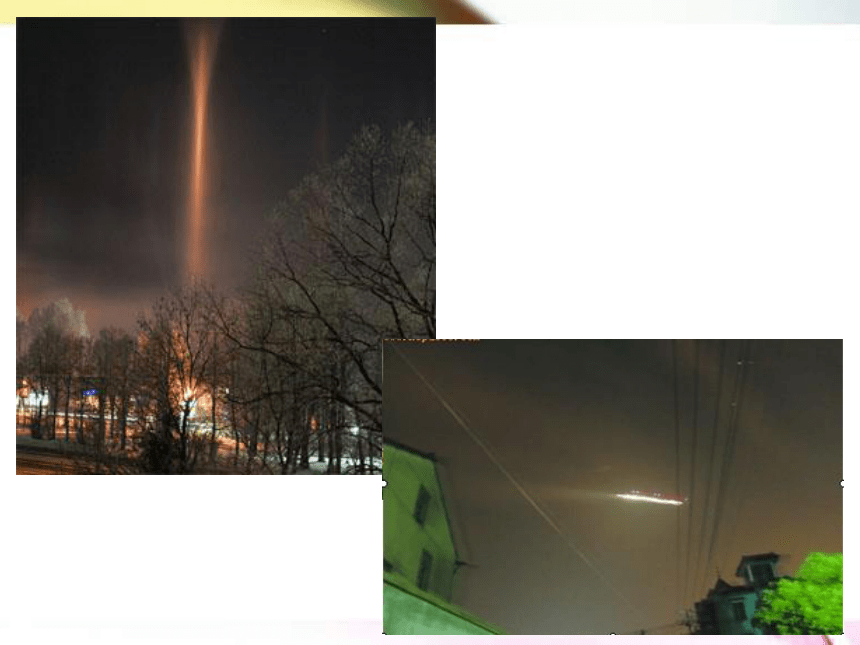
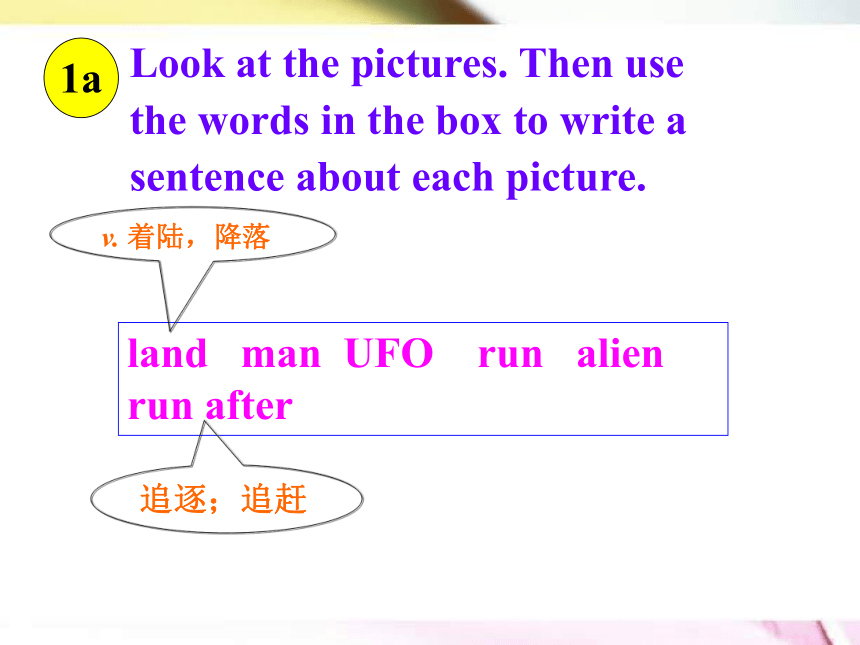
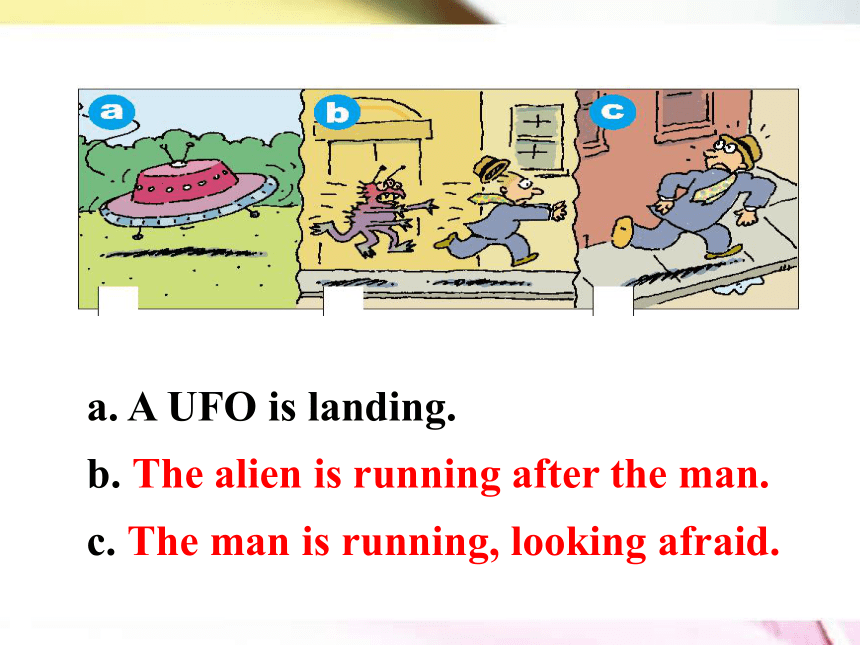
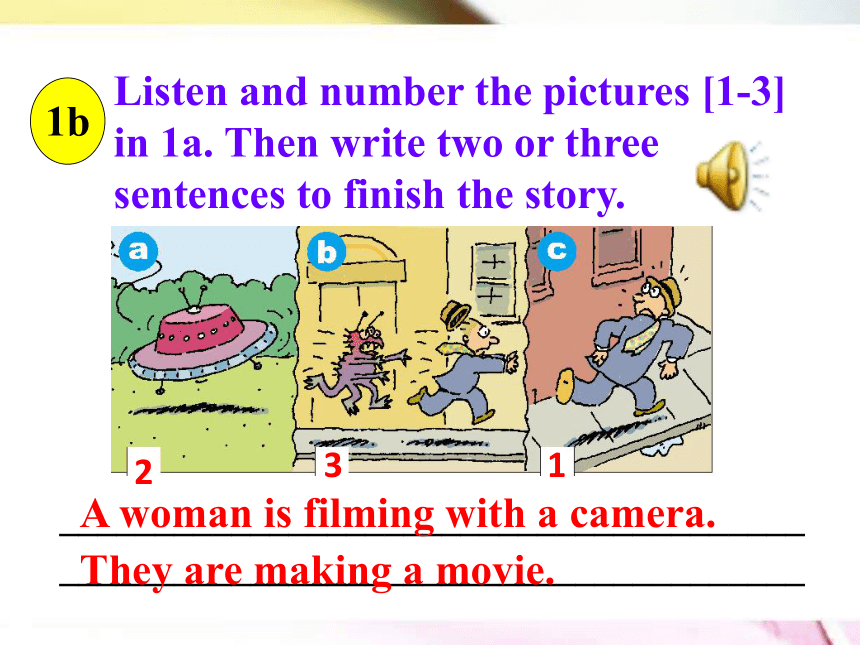
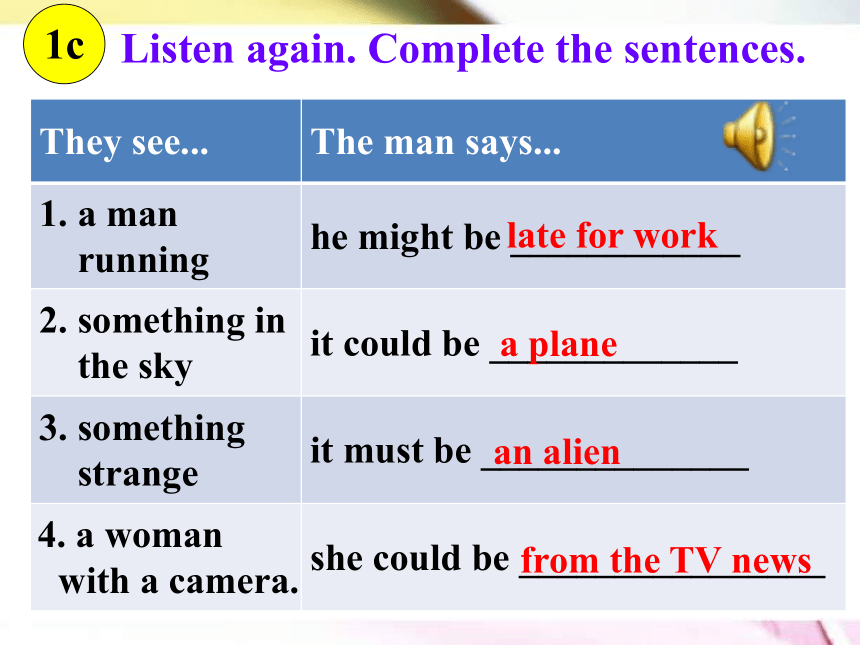
文档简介
Tell something about the strange things.
Victor,
a teacher
Helen
a woman
UFO
Are you interested in the UFO and aliens?
aliens
1a
Look at the pictures. Then use the words in the box to write a sentence about each picture.
land man UFO run alien
run after
v. 着陆,降落
追逐;追赶
a. A UFO is landing.
b. The alien is running after the man.
c. The man is running, looking afraid.
______________________________________________________________________________
1b
Listen and number the pictures [1-3] in 1a. Then write two or three sentences to finish the story.
2
3
1
A woman is filming with a camera. They are making a movie.
1c
Listen again. Complete the sentences.
late for work
a plane
an alien
from the TV news
They see... The man says...
1. a man
running he might be ____________
2. something in
the sky it could be _____________
3. something
strange it must be ______________
4. a woman
with a camera. she could be ________________
a UFO
dreaming
making a movie
running for exercise
They see... The woman says...
1. a man running he could be ________________
2. something in the
sky it must be _________
3. something
strange I must be __________
4. a woman with a
camera they must be _______________
1d
Role-play the conversation
between the man and the woman.
A: Why do you think the man is running?
B: He could be running for exercise.
A: No, he’s wearing a suit. He might be
running to catch a bus to work.
…
n. 西服,套装
2a
Match each linking word or phrase with its purpose.
express v. 表示,表达
Linking word or phrase Purpose of linking word or phrase
so expressing a difference
as, because, since giving a choice
but, however, though expressing a result
not only... but also ... expressing two things happening at the same time
or giving reasons
when, while adding information
Do you know the Stonehenge(巨石阵)? How much do you know about it?
2b
Skim the article below and underline the sentences with linking words or phrases. Do you think you have made correct matches in 2a?
IDENTIFYING LINKING LANGUAGE
Identifying conjunctions or phrases that link ideas together will help you understand what you read.
Stonehenge--Can Anyone Explain Why It Is There?
Stonehenge, a rock circle, is not only one of
n. 圆圈
Britain's most famous historical places but also
大不列颠
one of its greatest mysteries. Every year it
n. 奥秘,神秘事物
receives more than 750,000 visitors. People like to
v. 接受,收到
go to this place especially in June as they want to see the sun rising on the longest day of the year.
For many years, historians believed Stonehenge
n. 历史学家,历史工作者
was a temple where ancient leaders tried to
n. 领导,领袖
communicate with the gods. However, historian Paul Stoker thinks this can’t be true because Stonehenge was built so many centuries ago. “The leaders arrived in England much later,” he points out.
Another popular idea is that Stonehenge might be a kind of calendar. The large stones were put together in a certain way. On midsummer’s
n. 仲夏
morning, the sun shines directly into the center of the stones. Other people believe the stones have a medical purpose. They think the stones can
adj. 医疗的 n. 目的,目标
prevent illness and keep people healthy. “As you
v. 阻止,阻挠
walk there, you can feel the energy from your feet
n. 力量
move up your body,” said one visitor.
No one is sure what Stonehenge was used for, but most agree that the position of the stones must be
n. 位置,地方
for a special purpose. Some think it might be a burial place or a place to honor ancestors. Others
n. 埋葬,安葬 v. 表示敬意 n. 祖宗,祖先
think it was built to celebrate a victory over an enemy. n. 胜利,成功
n. 敌人,仇人
Stonehenge was built slowly over a long period of
n. 时期
time. Most historians believe it must be almost 5,000 years old. One of the greatest mysteries is how it was built because the stones are so big and heavy. In 2001, a group of English volunteers tried to build another Stonehenge, but they couldn’t . “We don’t really know who built Stonehenge,” says Paul Stoker. “And perhaps we might never know, but we do know they must have been hard-working--and great planners!”
adj. 工作努力的
2c
Read the article again and complete the chart.
Who built it?
What was it used for?
How was it built?
1. as a temple where ancient
leaders tried to
communicate with the gods
2. a kind of calendar
3. have a medical purpose
4. might be a burial place or a
place to honor ancestors
5. celebrate a victory over an
enemy
Mysteries about Stonehenge What Stonehenge might have been used for…
1. Midsummer day is in June _____ a lot of
people go to Stonehenge during this
month.
2. The sun shines straight into the center of
Stonehenge _______ the stones were put
in a special position.
2d
Complete the sentences using the words from the chart in 2a on page 62.
and
as
以一种特别的位置
3. Some people think the rocks can _________ stop people from becoming ill _________ keep them healthy.
4. We don’t know who built Stonehenge
_____ how it was built.
5. Historians think Stonehenge was built
about 5,000 years ago; _____________, they are not sure.
not only
but also
and
however
2e
Can you think of any other mysteries, either in China or another part of the world, that are similar to Stonehenge? What do you know about these mysteries? What is mysterious about them? Discuss them with your group.
Bermuda Triangle 百慕大三角洲
所谓百慕大三角,即指北起百慕大,西到美
国佛罗里达洲的迈阿密,南至波多黎各的一个三
角形海域。在这片面积达400000平方英里的海面
上,从1945年开始数以百计的飞机和船只,在这
里神秘地失踪。当然,这些失踪事件不包括那些
机械故障、政治绑架和海匪打劫等,因为这些本
不属于那种神秘失踪的范畴。
由于事件叠出,人们赋予这片海域以“魔鬼
三角”、“恶运海”、“魔海”、“海轮的墓地”等浑
号。这些浑号反过来又烘托了这里特有的神秘而
怖恐的气氛。
现在,百慕大三角已经成为那些神秘的、不
可理解的各种失踪事件的代名词。
1. express v. 表达,表示
expression n. 表达 ,表示,表情
e.g. It expresses my love for the novel.
这表达了我对这部小说的爱。
an expression of support 表示支持
2. receive v. 接受;收到
e.g. Yesterday I received his gift, but I
didn’t accept it so I returned it to him.
昨天我收到了他的礼物,但是我没有接受
并且退回去了。
3. leader n. 领导,领袖 lead v. 带领
e.g. Workers lead the leaders around the
factory.
工人带着领导参观工厂。
4. midsummer n. 仲夏, 中夏
mid-autumn 中秋
midnight 午夜
e.g. It is said that the story happened in the
midsummer.
据说故事发生在仲夏。
5. medical adj. 医疗的;医学的
medicine n. 药
e.g. Other people believe the stones have a
medical purpose.
其他人相信石头带有医疗目的。
6. prevent v. 阻止;阻挠
prevent sb. from doing 阻止某人做某事
=stop sb. from doing
e.g. Nothing can?prevent?us from carrying out
the plan. 什么也无法阻挡我们去实施这个计划。
7. energy n. 精力;力量
e.g. He is saving his energy for next week’s
race.
他正为下周的比赛养精蓄锐。
8. position n. 位置, 地方, 姿势
e.g Tom raised himself to a sitting position.
汤姆坐了起来。
9. burial n. 埋葬;安葬 bury v. 埋
e.g. His body was brought back to England
for?burial. 他的遗体已运回英国埋葬。
10. honor v. 尊重,表示敬意 n. 荣幸(=honour)
e.g. It’s my honor to stand here to give my speech.
我很荣幸能站在这儿作演讲。
11. victory n. 胜利,成功
e.g. They celebrated their?victory?cheerily.? ?
他们兴高采烈地庆祝胜利。
12. enemy n. 敌人,仇人
e.g. He’s made a lot of enemies.
他树敌很多。
13. period n. 一段时间;时期
e.g. the most difficult periods of history
历史上最艰难的时期
14. For many years, historians believed
Stonehenge was a temple where ancient
leaders tried to communicate with the gods.
多年以来,历史学家们认为巨石阵是古代首
领用来与神灵沟通的一座神庙。
此句中的where ancient leaders tries to
communicate with the gods是由关系副词
where引导的一个定语从句,修饰名词
temple.
15. The large stones were put together in a
certain way.
这些大块的石头以某种方式被摆放在一起。
in a certain way表示“以某种方式”,其中
certain表示 “某一;某个;某些”的意思,用于名词之前。
e.g. The doctor is only at this hospital on
certain days.
那位医生只有在某些日子才在这所医院。
16. As you walk there, you can feel the energy
from your feet move up your body.
当你走到那儿,你能感觉到能量从你的双脚
上升到你的身体里。
此句中的feel是感官动词,其后可接宾语和
不带to的动词不定式充当的宾语补足语,其
用法与see, hear, watch等词一样。
e.g. We felt the house shake.
Find more information about the
mysterious things.
Victor,
a teacher
Helen
a woman
UFO
Are you interested in the UFO and aliens?
aliens
1a
Look at the pictures. Then use the words in the box to write a sentence about each picture.
land man UFO run alien
run after
v. 着陆,降落
追逐;追赶
a. A UFO is landing.
b. The alien is running after the man.
c. The man is running, looking afraid.
______________________________________________________________________________
1b
Listen and number the pictures [1-3] in 1a. Then write two or three sentences to finish the story.
2
3
1
A woman is filming with a camera. They are making a movie.
1c
Listen again. Complete the sentences.
late for work
a plane
an alien
from the TV news
They see... The man says...
1. a man
running he might be ____________
2. something in
the sky it could be _____________
3. something
strange it must be ______________
4. a woman
with a camera. she could be ________________
a UFO
dreaming
making a movie
running for exercise
They see... The woman says...
1. a man running he could be ________________
2. something in the
sky it must be _________
3. something
strange I must be __________
4. a woman with a
camera they must be _______________
1d
Role-play the conversation
between the man and the woman.
A: Why do you think the man is running?
B: He could be running for exercise.
A: No, he’s wearing a suit. He might be
running to catch a bus to work.
…
n. 西服,套装
2a
Match each linking word or phrase with its purpose.
express v. 表示,表达
Linking word or phrase Purpose of linking word or phrase
so expressing a difference
as, because, since giving a choice
but, however, though expressing a result
not only... but also ... expressing two things happening at the same time
or giving reasons
when, while adding information
Do you know the Stonehenge(巨石阵)? How much do you know about it?
2b
Skim the article below and underline the sentences with linking words or phrases. Do you think you have made correct matches in 2a?
IDENTIFYING LINKING LANGUAGE
Identifying conjunctions or phrases that link ideas together will help you understand what you read.
Stonehenge--Can Anyone Explain Why It Is There?
Stonehenge, a rock circle, is not only one of
n. 圆圈
Britain's most famous historical places but also
大不列颠
one of its greatest mysteries. Every year it
n. 奥秘,神秘事物
receives more than 750,000 visitors. People like to
v. 接受,收到
go to this place especially in June as they want to see the sun rising on the longest day of the year.
For many years, historians believed Stonehenge
n. 历史学家,历史工作者
was a temple where ancient leaders tried to
n. 领导,领袖
communicate with the gods. However, historian Paul Stoker thinks this can’t be true because Stonehenge was built so many centuries ago. “The leaders arrived in England much later,” he points out.
Another popular idea is that Stonehenge might be a kind of calendar. The large stones were put together in a certain way. On midsummer’s
n. 仲夏
morning, the sun shines directly into the center of the stones. Other people believe the stones have a medical purpose. They think the stones can
adj. 医疗的 n. 目的,目标
prevent illness and keep people healthy. “As you
v. 阻止,阻挠
walk there, you can feel the energy from your feet
n. 力量
move up your body,” said one visitor.
No one is sure what Stonehenge was used for, but most agree that the position of the stones must be
n. 位置,地方
for a special purpose. Some think it might be a burial place or a place to honor ancestors. Others
n. 埋葬,安葬 v. 表示敬意 n. 祖宗,祖先
think it was built to celebrate a victory over an enemy. n. 胜利,成功
n. 敌人,仇人
Stonehenge was built slowly over a long period of
n. 时期
time. Most historians believe it must be almost 5,000 years old. One of the greatest mysteries is how it was built because the stones are so big and heavy. In 2001, a group of English volunteers tried to build another Stonehenge, but they couldn’t . “We don’t really know who built Stonehenge,” says Paul Stoker. “And perhaps we might never know, but we do know they must have been hard-working--and great planners!”
adj. 工作努力的
2c
Read the article again and complete the chart.
Who built it?
What was it used for?
How was it built?
1. as a temple where ancient
leaders tried to
communicate with the gods
2. a kind of calendar
3. have a medical purpose
4. might be a burial place or a
place to honor ancestors
5. celebrate a victory over an
enemy
Mysteries about Stonehenge What Stonehenge might have been used for…
1. Midsummer day is in June _____ a lot of
people go to Stonehenge during this
month.
2. The sun shines straight into the center of
Stonehenge _______ the stones were put
in a special position.
2d
Complete the sentences using the words from the chart in 2a on page 62.
and
as
以一种特别的位置
3. Some people think the rocks can _________ stop people from becoming ill _________ keep them healthy.
4. We don’t know who built Stonehenge
_____ how it was built.
5. Historians think Stonehenge was built
about 5,000 years ago; _____________, they are not sure.
not only
but also
and
however
2e
Can you think of any other mysteries, either in China or another part of the world, that are similar to Stonehenge? What do you know about these mysteries? What is mysterious about them? Discuss them with your group.
Bermuda Triangle 百慕大三角洲
所谓百慕大三角,即指北起百慕大,西到美
国佛罗里达洲的迈阿密,南至波多黎各的一个三
角形海域。在这片面积达400000平方英里的海面
上,从1945年开始数以百计的飞机和船只,在这
里神秘地失踪。当然,这些失踪事件不包括那些
机械故障、政治绑架和海匪打劫等,因为这些本
不属于那种神秘失踪的范畴。
由于事件叠出,人们赋予这片海域以“魔鬼
三角”、“恶运海”、“魔海”、“海轮的墓地”等浑
号。这些浑号反过来又烘托了这里特有的神秘而
怖恐的气氛。
现在,百慕大三角已经成为那些神秘的、不
可理解的各种失踪事件的代名词。
1. express v. 表达,表示
expression n. 表达 ,表示,表情
e.g. It expresses my love for the novel.
这表达了我对这部小说的爱。
an expression of support 表示支持
2. receive v. 接受;收到
e.g. Yesterday I received his gift, but I
didn’t accept it so I returned it to him.
昨天我收到了他的礼物,但是我没有接受
并且退回去了。
3. leader n. 领导,领袖 lead v. 带领
e.g. Workers lead the leaders around the
factory.
工人带着领导参观工厂。
4. midsummer n. 仲夏, 中夏
mid-autumn 中秋
midnight 午夜
e.g. It is said that the story happened in the
midsummer.
据说故事发生在仲夏。
5. medical adj. 医疗的;医学的
medicine n. 药
e.g. Other people believe the stones have a
medical purpose.
其他人相信石头带有医疗目的。
6. prevent v. 阻止;阻挠
prevent sb. from doing 阻止某人做某事
=stop sb. from doing
e.g. Nothing can?prevent?us from carrying out
the plan. 什么也无法阻挡我们去实施这个计划。
7. energy n. 精力;力量
e.g. He is saving his energy for next week’s
race.
他正为下周的比赛养精蓄锐。
8. position n. 位置, 地方, 姿势
e.g Tom raised himself to a sitting position.
汤姆坐了起来。
9. burial n. 埋葬;安葬 bury v. 埋
e.g. His body was brought back to England
for?burial. 他的遗体已运回英国埋葬。
10. honor v. 尊重,表示敬意 n. 荣幸(=honour)
e.g. It’s my honor to stand here to give my speech.
我很荣幸能站在这儿作演讲。
11. victory n. 胜利,成功
e.g. They celebrated their?victory?cheerily.? ?
他们兴高采烈地庆祝胜利。
12. enemy n. 敌人,仇人
e.g. He’s made a lot of enemies.
他树敌很多。
13. period n. 一段时间;时期
e.g. the most difficult periods of history
历史上最艰难的时期
14. For many years, historians believed
Stonehenge was a temple where ancient
leaders tried to communicate with the gods.
多年以来,历史学家们认为巨石阵是古代首
领用来与神灵沟通的一座神庙。
此句中的where ancient leaders tries to
communicate with the gods是由关系副词
where引导的一个定语从句,修饰名词
temple.
15. The large stones were put together in a
certain way.
这些大块的石头以某种方式被摆放在一起。
in a certain way表示“以某种方式”,其中
certain表示 “某一;某个;某些”的意思,用于名词之前。
e.g. The doctor is only at this hospital on
certain days.
那位医生只有在某些日子才在这所医院。
16. As you walk there, you can feel the energy
from your feet move up your body.
当你走到那儿,你能感觉到能量从你的双脚
上升到你的身体里。
此句中的feel是感官动词,其后可接宾语和
不带to的动词不定式充当的宾语补足语,其
用法与see, hear, watch等词一样。
e.g. We felt the house shake.
Find more information about the
mysterious things.
同课章节目录
- Unit 1 How can we become good learners.
- Section A
- Section B
- Unit 2 I think that mooncakes are delicious!
- Section A
- Section B
- Unit 3 Could you please tell me where the restroom
- Section A
- Section B
- Unit 4 I used to be afraid of the dark.
- Section A
- Section B
- Unit 5 What are the shirts made of?
- Section A
- Section B
- Review of Units 1-5
- Unit 6 When was it invented?
- Section A
- Section B
- Unit 7 Teenagers should be allowed to choose their
- Section A
- Section B
- Unit 8 It must belong to Carla.
- Section A
- Section B
- Unit 9 I like music that I can dance to.
- Section A
- Section B
- Unit 10 You're supposed to shake hands.
- Section A
- Section B
- Review of Units 6-10
- Unit 11 Sad movies make me cry.
- Section A
- Section B
- Unit 12 Life is full of the unexpected
- Section A
- Section B
- Unit 13 We're trying to save the earth!
- Section A
- Section B
- Unit 14 I remember meeting all of you in Grade 7.
- Section A
- Section B
- Review of Units 11-14
